VOL.1 S T U D I O S FUNDAMENTALS OF ECONOMICS AND MANAGEMENT BTECH 3RD YEAR UNIT 1 TO UNIT 5 35 PAGES
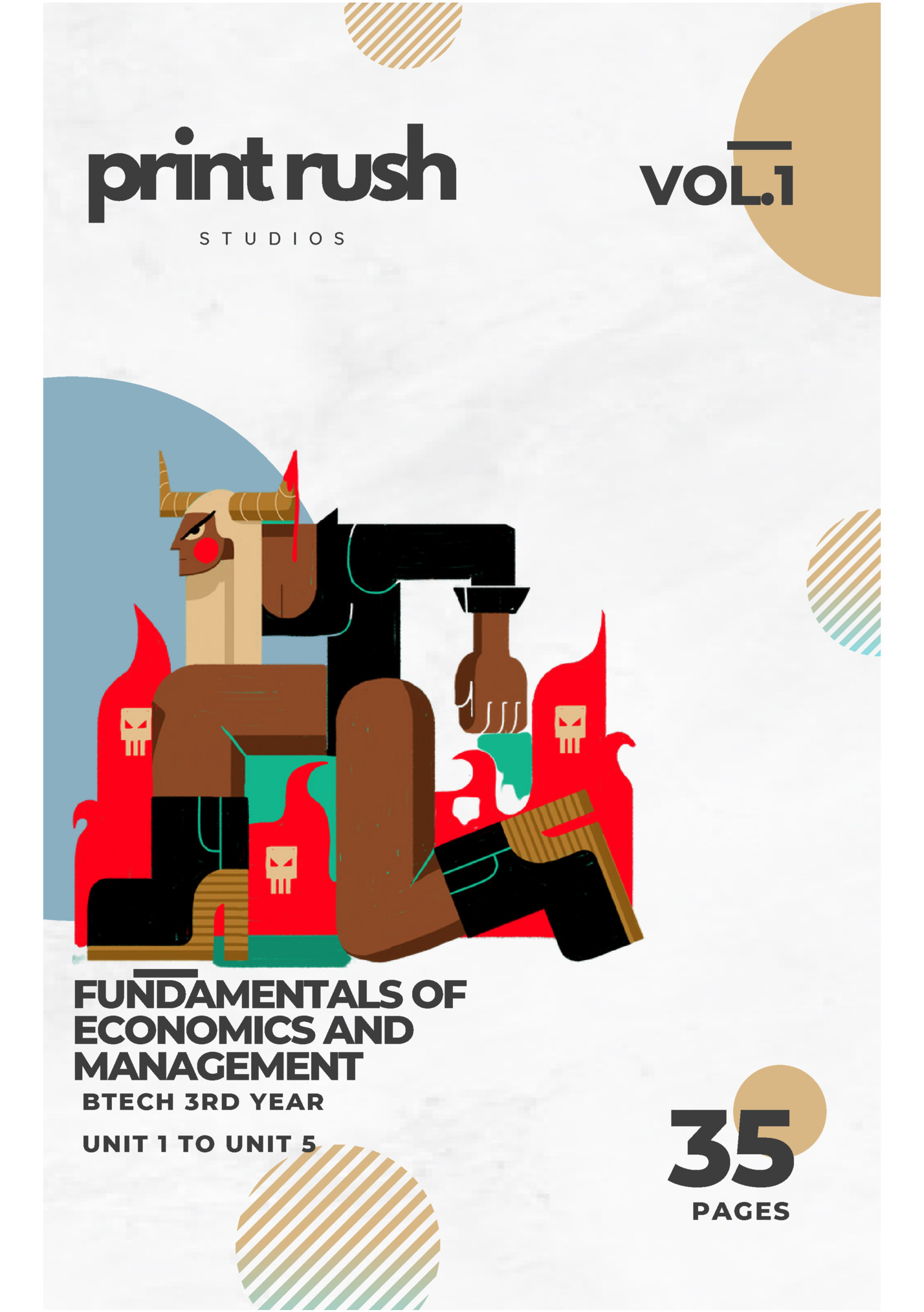
Concepts of management Management- [End Sem- 2019 ] It is a process or art of getting things done through others. It involves planning, organising, coordinating and directing a group of people to achieve a specific goal with best use of resources. Features of management: 1. Pervasive: Management is essential for the functioning of all types of organisations, be they social, economic, or political. 2. Multidimensional: Management has three main dimensions: ● Work Management: Focused on achieving organisational goals through problem-solving, decision-making, planning, budgeting, assigning responsibilities, and delegating authority. ● Management of People: Involves getting work done through people, recognizing individual strengths, addressing weaknesses, and dealing with people both as individuals and as part of a larger group. ● Management of Operations: Concerned with overseeing the production process that transforms inputs into outputs, linking the management of work and people. 3. Dynamic Function: Management is dynamic and must adapt to changing social, economic, and political conditions for an organisation to succeed. Flexibility and adaptability are crucial for effective management. 4. Group Activity: Organisations are composed of diverse individuals with different motivations, but management ensures that these individuals work together towards common organisational goals. Effective management channels individual efforts in the right direction. 5. Intangible Force: Although management itself cannot be touched, its effectiveness is evident in the order within an organisation, employee satisfaction, and the achievement of organisational goals. Good management creates a tangible impact on the organisation. 6. Continuous Process: Management is an ongoing, continuous process that is essential for the smooth functioning of every aspect of an organisation, including production systems, human resources, finance, and marketing. It is not a one-time activity but a continuous effort. Importance of Management: 1. Goal Achievement: Essential for aligning resources and guiding strategies to achieve organisational goals. 2. Individual Growth: Responsible for assisting individuals in reaching personal goals, creating a link between individual and organisational success. 3. Dynamic Adaptation: Ensures organisations stay dynamic, adapting to industry trends and avoiding stagnation.
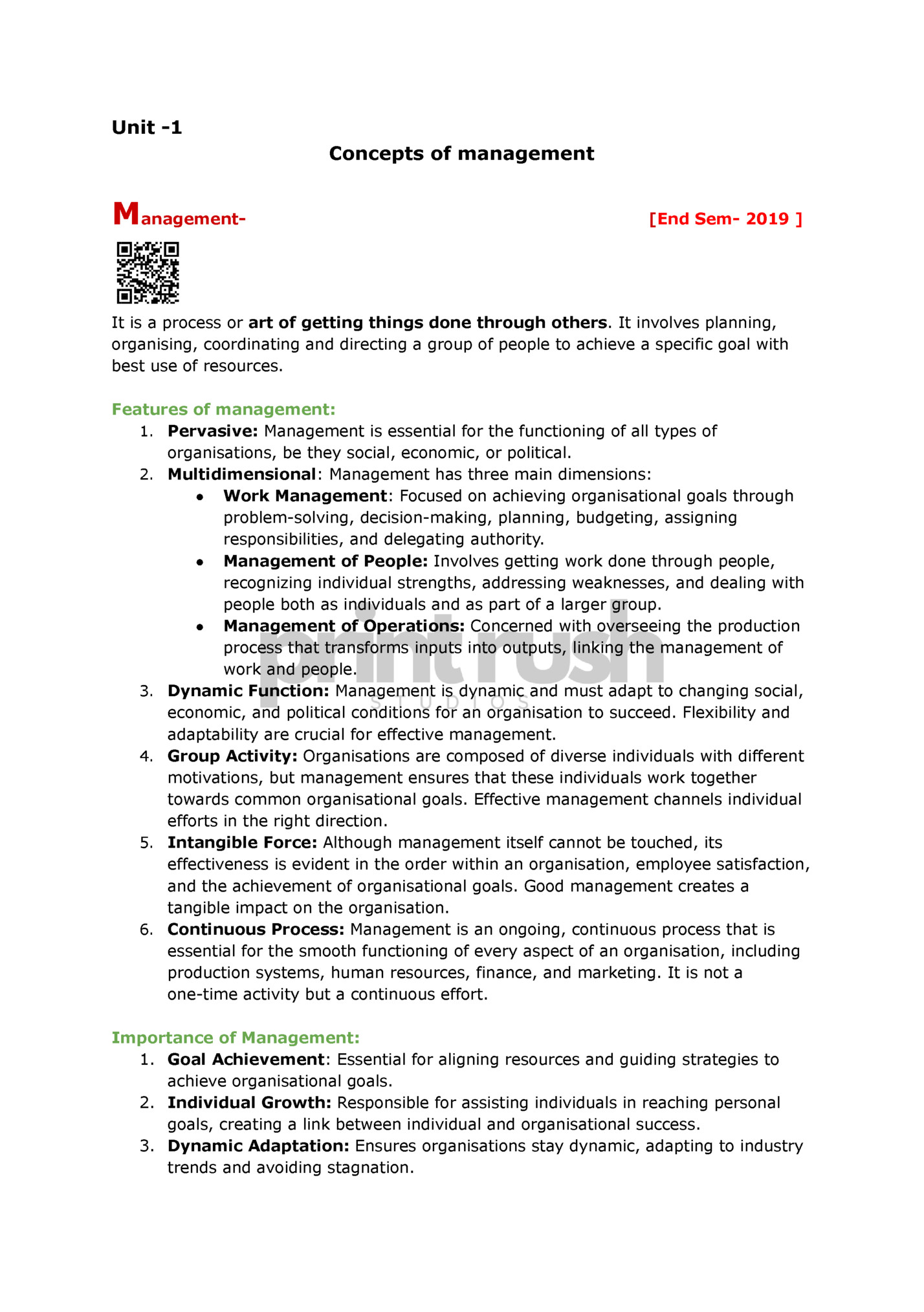
responsibilities alongside achieving organisational goals. 5. Efficiency Improvement: Through planning, controlling, directing, and organising, management enhances organisational efficiency, reducing costs and boosting productivity. Management as an Art:(end sem 2028 2m) ● Creativity and Skill: Requires creativity and skill developed through experience. ● Visionary Approach: Involves creating and achieving a vision of order from chaos. ● Organizing Human Talent: Described as the "art of arts," emphasising human talent organisation. Management as a Science: ● Systematic Pattern: Follows a systematic pattern similar to scientific inquiry. ● Data Gathering and Analysis: Involves gathering and analysing data for decision-making. ● Inexact Nature: Considered a soft science due to the inherent unpredictability of human factors. Difference between management and administration. [End Sem 2019,2022 7m] Basis of function Management Administration Meaning Art of getting things done through others towards goals. Concerned with formulating broad objectives, plans, policies. Nature Executing function. Decision-making function. Process Decides who and how should do the work. Decides what and when the work should be done. Function Doing function, involving supervision. Thinking function, determining plans and policies. Skills Technical and Human skills. Conceptual and Human skills. Level Middle & lower-level function. Top-level function. (Basis of usage) Applicability Applicable to profit-making organisations (businesses). Applicable to non-business organisations (clubs, schools). Influence Influenced by managers' values, opinions, beliefs. Influenced by public opinion, government policies, customs. Status Constitutes paid employees. Represents owners, earning returns on capital invested.

[End Sem 2019, MST 1 2023] 1. Planning: a. Definition: Involves deciding future actions, specifying objectives, and 2. 3. 4. 5. determining steps to achieve them. b. Importance: Essential function that bridges the gap from initiation to goal attainment. c. Elements: Decision-making, problem-solving, and avoidance of confusion and risks. d. Example: Ram plans the production and sale of shoes, deciding quantities, varieties, and resource allocation. Organising: Aligning physical, financial, and human resources to establish productive relationships. a. Function: Allotting duties, grouping activities, establishing authority, and allocating resources. Determines who, where, and when tasks are performed, affecting the organisation's structure. b. Example: Ram allocates duties within his shoe enterprise, forming groups and establishing an organisational hierarchy. Staffing: Involves hiring and developing personnel for various organisational positions. a. Function: Addresses recruitment, selection, placement, development, and retention of human resources. Ensures the right people, with the right qualifications, are in the right positions. b. Example: Ram hires personnel with the right qualifications for specific tasks in his shoe enterprise. Directing: Ensures efficient and effective work by leading, influencing, instructing, guiding, and inspiring employees. a. Elements: Communication, issuing orders, overseeing work, creating a positive work environment. b. Role: Brings out the best in employees through praise, constructive criticism, and effective leadership. Controlling: Monitors organisational performance towards goal fulfilment, detects errors, and takes corrective actions. a. Purpose: Identifies deficiencies, rectifies mistakes, and ensures work aligns with predetermined standards. b. Process: Measurement of goals against standards and correction of deviations. c. Example: Ram controls his enterprise's performance against the standard of selling 1,000 pairs of shoes per week, taking corrective actions as needed.
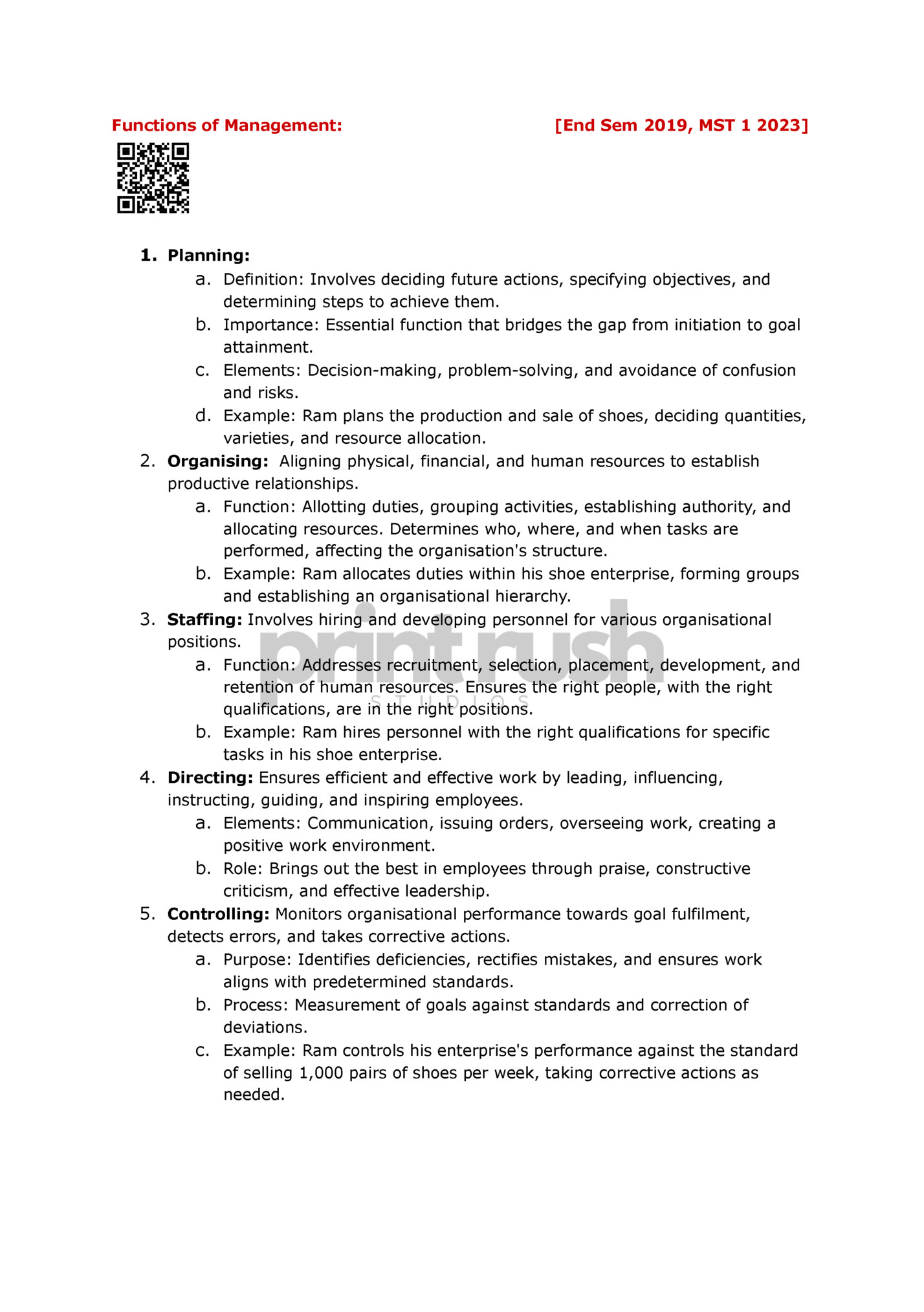
[End Sem 2018] ❖ Top Level/Administrative: ➢ Composition: Board, CEO, Managing Director. ➢ Role: ■ Sets objectives and policies. ■ Appoints middle-level executives. ■ Coordinates activities and maintains external contacts. ❖ Middle Level/Executory: ➢ Composition: Branch and departmental managers. ➢ Role: ■ Executes plans and policies. ■ Coordinates within departments. ■ Evaluates junior managers' performance. ❖ Low Level/Supervisory: ➢ Composition: Supervisors, foremen, section officers. ➢ Activities: ■ Assigns tasks to workers. ■ Guides daily activities and ensures production quality. ■ Communicates worker issues to higher levels. ■ Maintains discipline and provides training. Managerial Roles: 1. Interpersonal: ● Figurehead: Symbolic authority with legal or social duties. ● Leader: Builds and leads a motivated team. ● Liaison: Develops external networks for information. 2. Informational: ● Monitor: Seeks information on internal and external issues.

● Disseminator: Transmits important information. Spokesperson: Represents the team and provides information. 3. Decisional: ● Entrepreneur: Initiates and encourages innovation. ● Disturbance Handler: Corrects unexpected difficulties. ● Resource Allocator: Allocates resources optimally. ● Negotiator: Represents the organization in negotiations. Managerial Skills: [End Sem 2018] 1. Interpersonal Skills: Collaboration, relationship building, teamwork. Essential for effective leadership. 2. Conceptual Skills: Decision-making through working with ideas and concepts. 3. Technical Skills: Using tools and techniques, e.g., proficiency in software. 4. Communication Skills: Understanding business needs, clear communication for leadership. 5. Leadership Skills: Guiding teams, fostering a positive work environment. Sought-after for inspiring others. 6. Problem Solving and Decision-Making: Spotting and solving problems, creative decision-making. Critical for maintaining productivity and making quick decisions. Decision Making Process: [End Sem 2018, 2022] 1. Identify the Decision: Clarify the goal and how success will be measured. 2. Gather Relevant Information/Frame the Problem: Analyse the problem from various perspectives. 3. Identify Alternative Solutions: Consider diverse needs of stakeholders. 4. Choose Among the Alternatives: Evaluate the impact of each alternative on stakeholders.Consider creative and blended solutions, rejecting false tradeoffs. 5. Take Action/Implementation: Develop an implementation plan. Execute the chosen solution and monitor progress. 6. Review Decision and its Impact+Learn from Feedback: ● Monitor success metrics defined in step 1. ● Assess the impact on the team and stakeholders. ● Adapt and make iterative decisions if needed. Types of Decisions in Management: 1. Programmed and Non-Programmed Decisions: ● Programmed Decisions: Routine and repetitive, dealing with common organisational issues.

Non-Programmed Decisions: Exceptional situations lacking established guidelines. 2. Operational and Strategic Decisions: ● Operational Decisions: Normal functioning, delegated responsibilities, ● shorter time. Strategic Decisions: Address present issues, aim for better conditions, equipment, and efficiency. Typically made by top-level management. 3. Organisational and Personal Decisions: ● Organisational Decisions: Made collectively for organisational goals. ● Personal Decisions: Made by individuals, affecting personal life, with potential impact on the organisation. 4. Major and Minor Decisions: ● Major Decisions: Significant, such as the purchase of new premises, made ● by top management. Minor Decisions: Routine decisions, like purchasing stationery, can be made by lower-level managers. 5. Individual and Group Decisions: ● Individual Decisions: Made by individuals within the organization's policy ● framework. Group Decisions: Involving a committee, often for important decisions, aiming for maximum involvement. 6. Tactical and Operational Decisions: ● Tactical Decisions: Policy matters with long-term impact, made by top ● management (e.g., plant location). Operational Decisions: Day-to-day decisions for proper functioning, made by middle or lower-level managers (e.g., bonus calculations). Decision Making Scenarios: ➔ Under Certainty: ● Known cause and effect. ● Obvious and controllable outcomes. ● Process: Choose the option maximizing utility. ➔ Under Uncertainty: ● Multiple consequences, unknown probabilities. ● Lack of information and unpredictable variables. ➔ Under Risk: ● ● ● Multiple consequences, known probabilities. Requires application of experience and knowledge. Intermediate scenario between certainty and uncertainty.
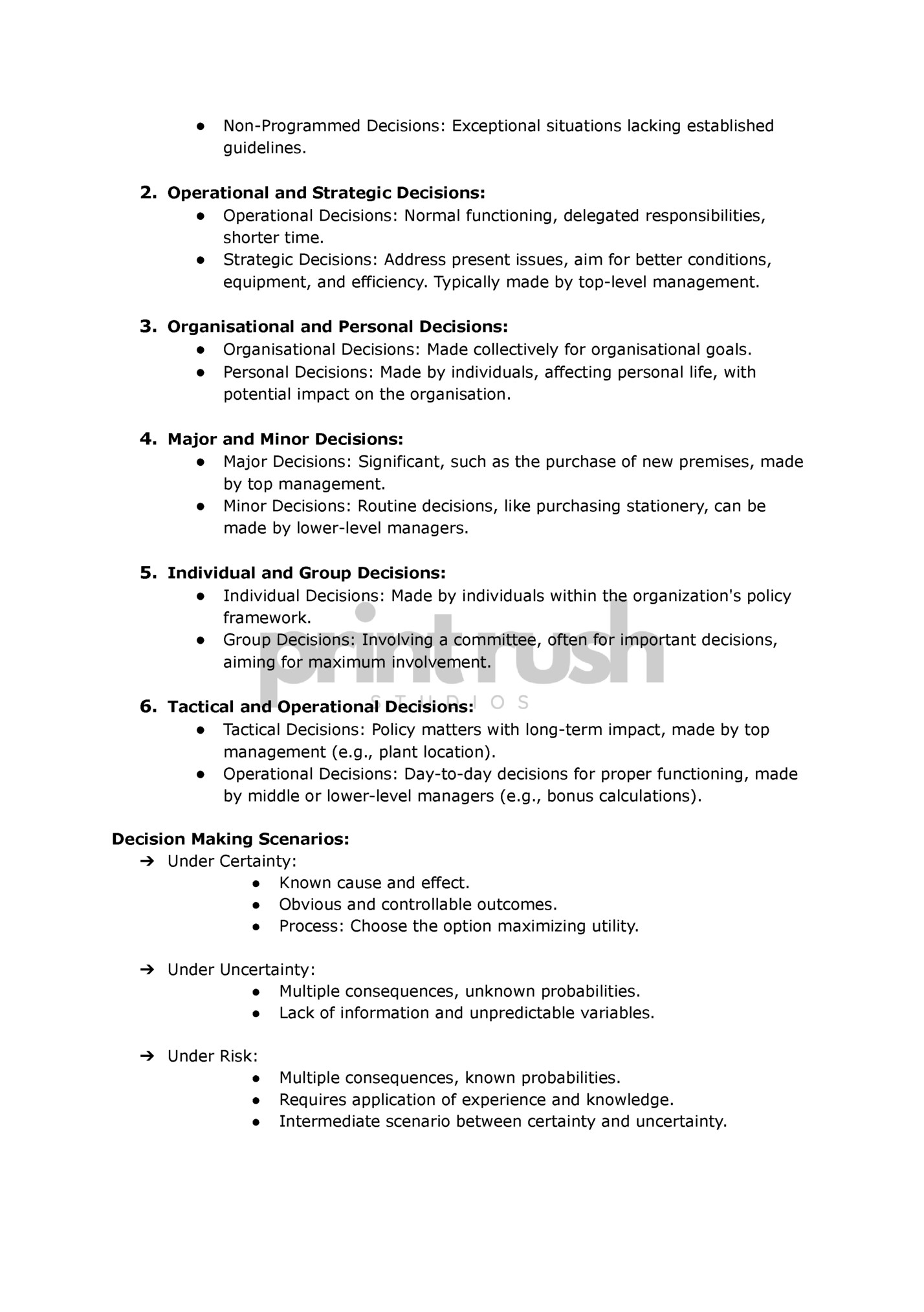
[End Sem 2019, End Sem 2022] Cross-culture management involves understanding and navigating the differences among people from various nations, backgrounds, and ethnicities. Cross-Culture Issues and Resolutions: 1. Communication Styles: ● Recognize differences in communication styles (low-context vs. high-context). ● Adapt communication to enhance effectiveness in cross-cultural teams. 2. Cultural Values: ● Acknowledge variations in cultural values using Geert Hofstede's dimensions. ● Understand power distance, individualism vs. collectivism, masculinity vs. femininity, uncertainty avoidance, and long-term vs. short-term orientation. 3. Effective Communication Style: ● Develop communication styles aligned with cultural differences. ● Foster openness, flexibility, and emotional intelligence for better cross-cultural communication. 4. Avoiding Frustration: ● Open up to cultural differences and seek understanding. ● Learn about values that dictate behaviors, fostering a cooperative environment. 5. Appropriate Motivations: ● Tailor motivational techniques and incentives to accommodate cultural preferences. ● Consider individual preferences within diverse teams to enhance productivity. Cross-Culture Challenges: 1. Different Communication Styles: ● Variations in language usage, non-verbal cues, and assertiveness. ● Awareness of cultural norms in communication to avoid misunderstandings. 2. Attitudes Toward Conflict: ● Differing views on conflict resolution as positive or to be avoided. ● Recognition of cultural preferences in addressing conflicts. 3. Decision-Making Styles: ● Varying roles in decision-making, from delegation to individual responsibility. ● Understanding the influence of cultural frames on decision-making approaches. 4. Attitudes Toward Disclosure:
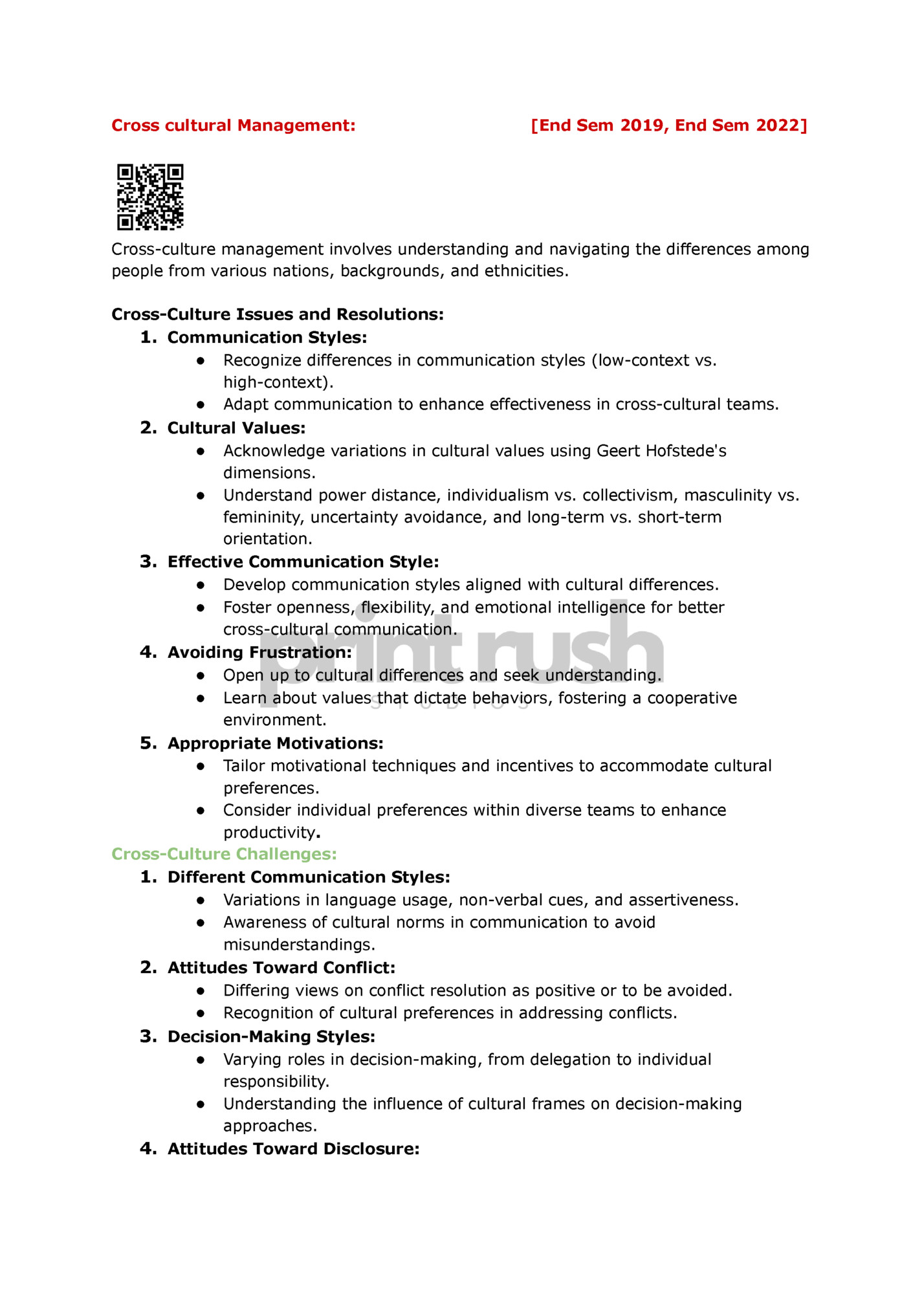
● Differences in openness about emotions, conflicts, and personal information. Respect for cultural variations in disclosure preferences during interactions.

Fleepit Digital © 2021